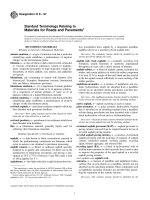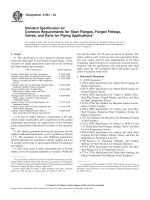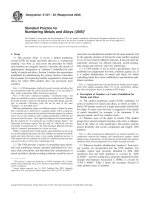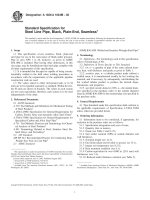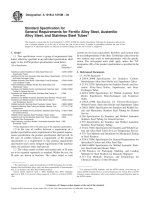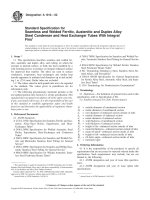Tiêu chuẩn ASTM a694 a694m 03 ;QTY5NC9BNJK0TQ
Bạn đang xem bản rút gọn của tài liệu. Xem và tải ngay bản đầy đủ của tài liệu tại đây (24.59 KB, 3 trang )
Designation: A 694/A 694M – 03
Standard Specification for
Carbon and Alloy Steel Forgings for Pipe Flanges, Fittings,
Valves, and Parts for High-Pressure Transmission Service1
This standard is issued under the fixed designation A 694/A 694M; the number immediately following the designation indicates the year
of original adoption or, in the case of revision, the year of last revision. A number in parentheses indicates the year of last reapproval.
A superscript epsilon (e) indicates an editorial change since the last revision or reapproval.
TABLE 1 Tensile Requirements
1. Scope*
1.1 This specification covers forged or rolled steel pipe
flanges, forged fittings, valves, and parts suitable for use with
high-strength transmission-service pipe. Included are flanges,
fittings, and similar parts ordered either to dimensions specified
by the purchaser or to ASME or MSS dimensional standards
referenced in Section 2.
1.2 Several grades of material, based on minimum yield
strength requirements, are covered, as indicated in Table 1.
1.3 Supplementary Requirements are provided. Supplementary Requirement S 1 is provided for use when purchaser
approval is required for repair welding.
1.4 This specification is expressed in both inch-pound units
and in SI units. However, unless the order specifies the
applicable “M” specification designation (SI units), the material shall be furnished to inch-pound units.
1.5 The values stated in either inch-pound units or SI units
are to be regarded separately as standard. Within the text, the
SI units are shown in brackets. The values stated in each
system are not exact equivalents; therefore, each system must
be used independently of the other. Combining values from the
two systems may result in nonconformance with the specification.
Grade
Yield Strength (0.2 %
Offset), min, ksi [MPa]
F42
F46
F48
F50
F52
F56
F60
F65
F70
42
46
48
50
52
56
60
65
70
[290]
[315]
[330]
[345]
[360]
[385]
[415]
[450]
[485]
Tensile Strength,
min, ksi [MPa]
60
60
62
64
66
68
75
77
82
[415]
[415]
[425]
[440]
[455]
[470]
[515]
[530]
[565]
Elongation in 2
in. or 50 mm,
min %
20
20
20
20
20
20
20
20
18
Use with High-Pressure Transmission Systems
A 707/A 707M Specification for Forged Carbon and Alloy
Steel Flanges for Low-Temperature Service
A 788 Specification for Steel Forgings, General Requirements
A 961 Specification for Common Requirements for Steel
Flanges, Forged Fittings, Valves, and Parts for Piping
Applications
2.3 ASME Standards:
ASME B 16.5 Steel Pipe Flanges and Flanged Fittings3
ASME B 16.9 Steel Butt-Welding Fittings3
ASME B 16.10 Face-to-Face and End-to-End Dimensions
of Ferrous Valves3
ASME B 16.11 Forged Steel Fittings, Socket Welding and
Threaded3
ASME B 16.28 Wrought Steel Butt-Welding Short Radius
Elbows3
ASME B 16.47 Large Diameter Steel Flanges3
2.4 MSS Standards:4
MSS SP-44 Standard for Steel Pipe Line Flanges
MSS SP-75 Specification for High-Test Welding Fittings
MSS SP-95 Swage (d) Nipples and Bull Plugs
MSS SP-97 Integrally Reinforced Forged Branch Outlet
Fittings
2.5 API Standard:
2. Referenced Documents
2.1 In addition to those reference documents listed in
Specification A 961, the following list of standards apply to
this specification:
2.2 ASTM Standards: 2
A 53/A 53M Specification for Pipe, Steel, Black and HotDipped, Zinc-Coated, Welded and Seamless
A 106 Specification for Seamless Carbon Steel Pipe for
High-Temperature Service
A 381 Specification for Metal-Arc-Welded Steel Pipe for
1
This specification is under the jurisdiction of ASTM Committee A01 on Steel,
Stainless Steel, and Related Alloys, and is the direct responsibility of Subcommittee
A01.22 on Valves and Fittings.
Current edition approved October 1, 2003. Published November 2003. Originally
approved in 1974. Last previous edition approved in 2000 as A 694/A 694M – 00.
2
For referenced ASTM standards, visit the ASTM website, www.astm.org, or
contact ASTM Customer Service at For Annual Book of ASTM
Standards volume information, refer to the standard’s Document Summary page on
the ASTM website.
3
Available from American Society of Mechanical Engineers, Three Park
Avenue, New York, NY 10016-5990.
4
Available from the Manufacturers’ Standardization Society of the Valve and
Fittings Industry, 127 Park St., Northeast, Vienna, VA 22180.
*A Summary of Changes section appears at the end of this standard.
Copyright © ASTM International, 100 Barr Harbor Drive, PO Box C700, West Conshohocken, PA 19428-2959, United States.
1
A 694/A 694M – 03
5L Specification for Line Pipe5
6. Chemical Composition
6.1 A chemical heat analysis in accordance with Specification A 961 shall be made and conform to the requirements as to
chemical composition prescribed in Table 2.
6.2 High-strength low-alloy steels shall be of specified alloy
element composition, with the elements covered in 6.1 restricted within the limits prescribed therein as may be necessary to ensure weldability and specified minimum tensile
properties. When high-strength low-alloy steel is furnished,
appropriate procedures are required for field welding.
6.3 Alloy steel shall conform to the requirements for Grade
L 5 of Specification A 707/A 707M .
3. Ordering Information
3.1 It is the purchaser’s responsibility to specify in the
purchase order all ordering information necessary to purchase
the needed material. In addition to the ordering guidelines in
Specification A 961, orders should include the following information:
3.1.1 Additional requirements (see 8.1 and 10.1).
4. General Requirements
4.1 Product furnished to this specification shall conform to
the requirements of Specification A 961, including any supplementary requirements that are indicated in the purchase order.
Failure to comply with the general requirements of Specification A 961 constitutes nonconformance with this specification.
In case of conflict between the requirements of this specification and Specification A 961, this specification shall prevail.
7. Tensile Requirements
7.1 The material shall conform to the requirements as to
tensile properties prescribed in Table 1, when tested in accordance with the mechanical testing requirements of Specification A 961.
7.2 The tension test specimen shall be obtained from a
production forging, or from an integral prolongation representative of the hub location of a flange, or the heaviest cross
section of a fitting, valve, or other part within the scope of this
specification. Alternatively, the test specimen may be taken
from a separately forged test block which has been taken from
the same heat of steel as the production forgings, and which has
been reduced by forging in a manner similar to that for the
forgings it represents.
7.2.1 The test specimen shall represent all forgings from the
same heat and heat treatment load whose maximum thicknesses do not exceed the thickness of the test forging or blank
by more than 1⁄4 in. [6 mm].
7.3 The axis of the tension test sample shall be located in the
test forging, or prolongation so as to represent mid-wall of the
flange hub, or mid-wall of the thickest cross section of the
valve, fitting, or other part.
7.4 The axis of the tension test specimen shall be oriented
parallel to the direction of maximum forging work for fittings,
valves, and other parts, except for flanges when the specimen
shall be oriented in the tangential direction.
7.5 One tension test shall be taken from each heat in each
heat treatment load, and shall be representative of the largest
flange hub, or valve or fitting wall thickness in the load.
7.6 When heat treatment is done either continuous or batch
type furnaces in which the working zones are controlled to
within +/- 25°F [+/- 14°C] of the required heat treatment
temperature, and when the furnace is equipped with functioning recording pyrometers such that complete heat treatment
records are available, then one tension test from each heat shall
be required instead of from each heat in each heat treatment
5. Manufacture
5.1 Melting Process:
5.1.1 The steel shall be made by any of the following
processes: open hearth, electric furnace, or basic oxygen. The
steel shall be fully deoxidized.
5.1.2 The steel shall be carbon steel, high-strength low-alloy
steel, or alloy steel, as agreed upon between the manufacturer
and purchaser. Analysis of the steel used, including all alloying
elements, shall be reported by the manufacturer to the purchaser. The steel shall be suitable for field welding (as
established by the purchaser) to other fittings, valve materials
and flanges, and to pipe manufactured under the following
ASTM specifications: Specification A 53, Specification A 106,
Specification A 381, and API Standard 5L pipe, as well as to
fittings manufactured under MSS SP-75.
5.2 Manufacturing Practice:
5.2.1 Material for forgings shall consist of ingots or blooms,
billets, slabs, or bars of forged or rolled form and cut to the
required length by a suitable process.
5.2.2 The finished product shall be a forging as defined in
the Terminology section of Specification A 788.
5.2.3 Hot working shall be sufficient to develop a wrought
structure throughout the part.
5.2.4 Flanges shall not be machined directly from plate nor
from solid bar stock.
5.3 Heat Treatment:
5.3.1 All items shall be heat treated. Heat treatment of
carbon steel and high-strength low-alloy steel may consist of
normalizing, normalizing-and-tempering, or quenching-andtempering. Heat treatment of alloy steel may consist of
normalizing and precipitation heat treatment or quenching and
precipitation heat treatment.
5.3.2 The tempering temperature shall be at least 1000°F
[540°C]. The precipitation heat treatment of the alloy steel
shall be in the range from 1000 to 1225°F [540 to 665°C].
TABLE 2 Chemical Requirements
Composition, %
Carbon, max
Manganese, max
Phosphorus, max
Sulfur, max
Silicon
5
Available from American Petroleum Institute, 1801 K St. N. W., Washington,
DC 20037.
2
Heat Analysis
Product Analysis
0.26
1.40
0.025
0.025
0.15–0.35
0.265
1.44
0.030
0.030
0.10–0.40
A 694/A 694M – 03
11. Certification
load. However, this provision is limited to forgings with heat
treated weights not exceeding 10 000 lbs [4540 kg], and the
test forging must accompany a production charge.
11.1 Certification shall comply with Specification A 961.
However, if high-strength low-alloy steel is used, the analysis
and the heat number or manufacturer’s heat identification shall
be reported to the purchaser.
8. Workmanship, Finish, and Appearance
8.1 The forgings shall be free of injurious defects as defined
in Specification A 961.
8.2 Repair by Welding of Injurious Defects—Repair of
injurious defects shall be permitted at the discretion of the
manufacturer in accordance with Specification A 961.
8.2.1 Deposited weld metal shall be capable of meeting all
mechanical properties upon heat treatment.
8.2.2 All forgings to be repaired by welding shall be repair
welded prior to heat treatment.
12. Product Marking
12.1 Product marking shall comply with Specification A
961.
12.2 Forgings repaired by welding shall be marked with the
letter “W” following the ASTM designation.
12.3 Bar Coding—In addition to the requirements in 12.1
and 12.2, bar coding is acceptable as a supplemental identification method. The purchaser may specify in the order a
specific bar coding system to be used. The bar coding system,
if applied at the discretion of the supplier, should be consistent
with one of the published industry standards for bar coding. If
used on small parts, the bar code may be applied to the box or
a substantially applied tag.
9. Retests
9.1 If any of the results of the tension tests of any lot do not
conform to the requirements specified, the manufacturer may
reheat treat such lots, but not more than twice, except with the
approval of the purchaser, on the basis of satisfactory metallurgical evidence that the cause of failure is curable and the
quality of the material is satisfactory.
13. Keywords
10. Rejection and Rehearing
10.1 The purchaser shall comply with the requirements of
Specification A 961.
13.1 high strength low alloy steel; pipe fittings, steel; piping
applications; pressure containing parts; steel flanges; steel
forgings, alloy; steel forgings, carbon; steel valves
SUPPLEMENTARY REQUIREMENTS
The following supplementary requirements shall apply only when specified by the purchaser in the
inquiry, contract, and order:
S1. Special Flanges
S1.1 Flanges shall meet the requirements of MSS SP-44,
except the chemical requirements shall conform to Table 2.
SUMMARY OF CHANGES
Committee A01 has identified the location of selected changes to this specification since the last issue,
A 694/A 694M - 00, which may impact the use of this specification. (Approved October 1, 2003)
(1) Revised Section 10 to reference Specification A 961
requirements.
ASTM International takes no position respecting the validity of any patent rights asserted in connection with any item mentioned
in this standard. Users of this standard are expressly advised that determination of the validity of any such patent rights, and the risk
of infringement of such rights, are entirely their own responsibility.
This standard is subject to revision at any time by the responsible technical committee and must be reviewed every five years and
if not revised, either reapproved or withdrawn. Your comments are invited either for revision of this standard or for additional standards
and should be addressed to ASTM International Headquarters. Your comments will receive careful consideration at a meeting of the
responsible technical committee, which you may attend. If you feel that your comments have not received a fair hearing you should
make your views known to the ASTM Committee on Standards, at the address shown below.
This standard is copyrighted by ASTM International, 100 Barr Harbor Drive, PO Box C700, West Conshohocken, PA 19428-2959,
United States. Individual reprints (single or multiple copies) of this standard may be obtained by contacting ASTM at the above
address or at 610-832-9585 (phone), 610-832-9555 (fax), or (e-mail); or through the ASTM website
(www.astm.org).
3
